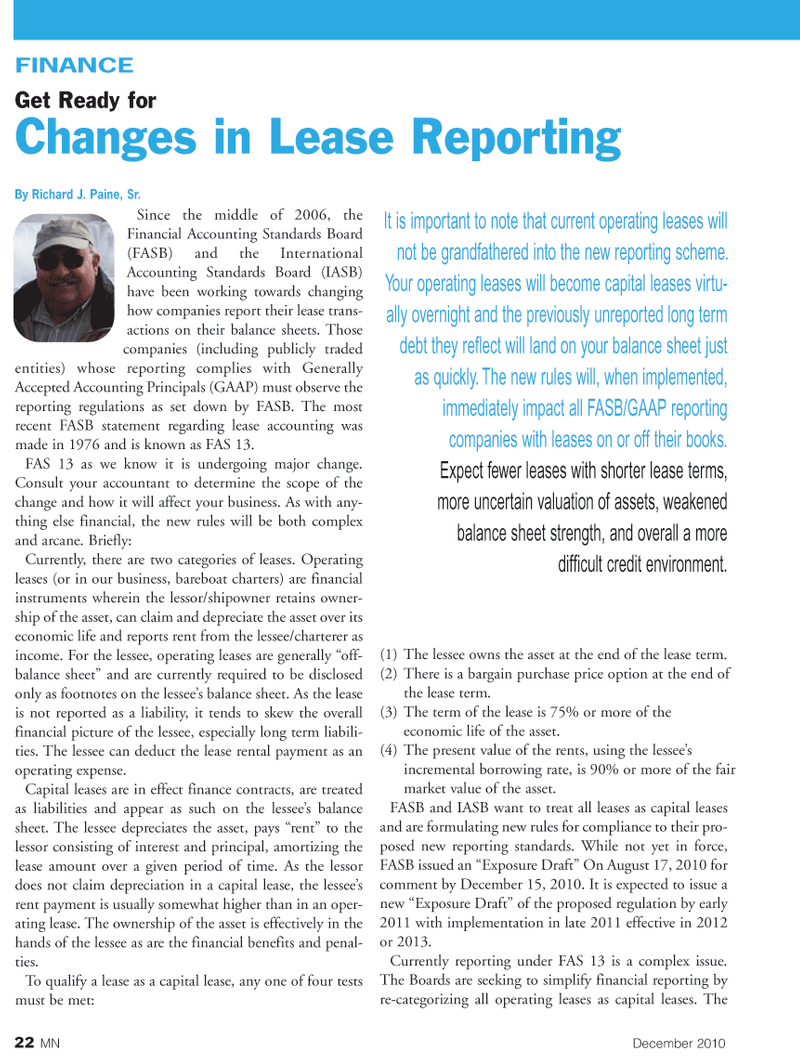
Page 22: of Marine News Magazine (December 2010)
Great Ships of 2010
Read this page in Pdf, Flash or Html5 edition of December 2010 Marine News Magazine
22 MN December 2010
FINANCE
Since the middle of 2006, the
Financial Accounting Standards Board (FASB) and the International
Accounting Standards Board (IASB) have been working towards changing how companies report their lease trans- actions on their balance sheets. Those companies (including publicly traded entities) whose reporting complies with Generally
Accepted Accounting Principals (GAAP) must observe the reporting regulations as set down by FASB. The most recent FASB statement regarding lease accounting was made in 1976 and is known as FAS 13.
FAS 13 as we know it is undergoing major change.
Consult your accountant to determine the scope of the change and how it will affect your business. As with any- thing else financial, the new rules will be both complex and arcane. Briefly:
Currently, there are two categories of leases. Operating leases (or in our business, bareboat charters) are financial instruments wherein the lessor/shipowner retains owner- ship of the asset, can claim and depreciate the asset over its economic life and reports rent from the lessee/charterer as income. For the lessee, operating leases are generally “off- balance sheet” and are currently required to be disclosed only as footnotes on the lessee’s balance sheet. As the lease is not reported as a liability, it tends to skew the overall financial picture of the lessee, especially long term liabili- ties. The lessee can deduct the lease rental payment as an operating expense.
Capital leases are in effect finance contracts, are treated as liabilities and appear as such on the lessee’s balance sheet. The lessee depreciates the asset, pays “rent” to the lessor consisting of interest and principal, amortizing the lease amount over a given period of time. As the lessor does not claim depreciation in a capital lease, the lessee’s rent payment is usually somewhat higher than in an oper- ating lease. The ownership of the asset is effectively in the hands of the lessee as are the financial benefits and penal- ties.
To qualify a lease as a capital lease, any one of four tests must be met: (1) The lessee owns the asset at the end of the lease term. (2) There is a bargain purchase price option at the end of the lease term. (3) The term of the lease is 75% or more of the economic life of the asset. (4) The present value of the rents, using the lessee’s incremental borrowing rate, is 90% or more of the fair market value of the asset.
FASB and IASB want to treat all leases as capital leases and are formulating new rules for compliance to their pro- posed new reporting standards. While not yet in force,
FASB issued an “Exposure Draft” On August 17, 2010 for comment by December 15, 2010. It is expected to issue a new “Exposure Draft” of the proposed regulation by early 2011 with implementation in late 2011 effective in 2012 or 2013.
Currently reporting under FAS 13 is a complex issue.
The Boards are seeking to simplify financial reporting by re-categorizing all operating leases as capital leases. The
Get Ready for
Changes in Lease Reporting
By Richard J. Paine, Sr.
It is important to note that current operating leases will not be grandfathered into the new reporting scheme.
Your operating leases will become capital leases virtu- ally overnight and the previously unreported long term debt they reflect will land on your balance sheet just as quickly. The new rules will, when implemented, immediately impact all FASB/GAAP reporting companies with leases on or off their books.
Expect fewer leases with shorter lease terms, more uncertain valuation of assets, weakened balance sheet strength, and overall a more difficult credit environment.

 21
21

 23
23
